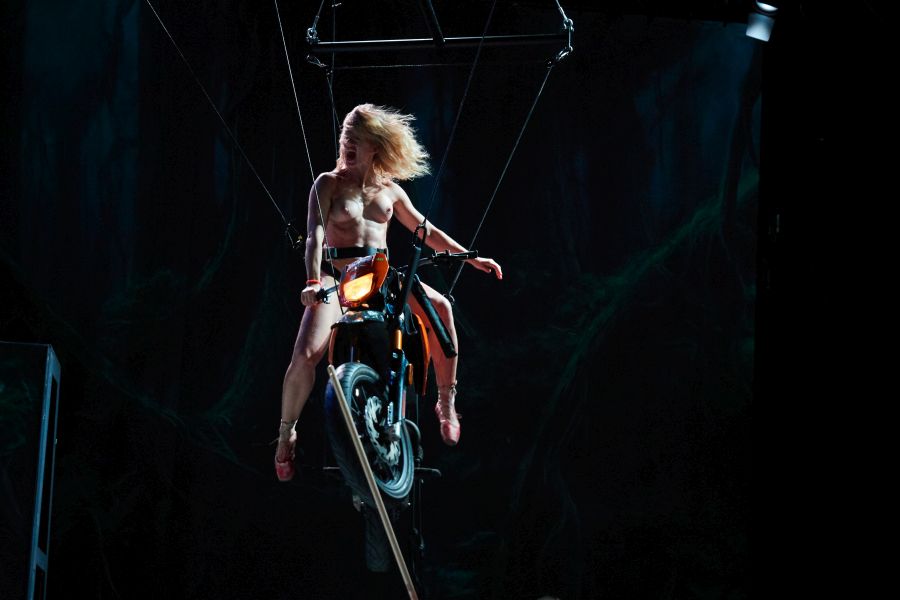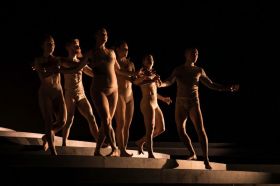To say that Austrian choreographer Florentina Holzinger is an artist poised at the cutting edge of contemporary dance world would be a misleading statement.
Given her penchant for body mutilation and deathly aerial flights on stage, it’s more accurate to say she’s not poised, but dangling by her teeth from a rope above our heads.
Holzinger’s work features nudity, bleeding, defecating and masturbating female bodies on stage, and has shocked and revolted many who’ve seen it. Though in doing so, the artist has stridently opened conversations about the kinds of female bodies we expect to see in dance on stage, and why we expect to see them.
Described by Berlin’s Volksbühne theatre’s Artistic Director René Pollesch as presenting ‘a radical feminism’ through her works, and explained by the artist herself as a way to ‘teach people something about what forms of shame are necessary and which are not’, Holzinger’s work raises questions of how certain social pressures leave their marks on women’s bodies.
The artist has just shown her work TANZ (2019) at Melbourne RISING Festival, and is currently presenting her much-anticipated season of A Divine Comedy (2021) at Dark Mofo.
In light of the artist’s visit to Australia, ArtsHub asks several Australian female choreographers for their thoughts on the themes within Holzinger’s work – especially when it comes to expectations of female bodies in dance.
What is Holzinger’s work bringing to the stage?
Melbourne-based choreographer Prue Lang is a prominent figure in the Australian dance sector, as an internationally recognised choreographer and, before that, as a dancer with companies like Australian Dance Theatre (with Meryl Tankard), William Forsythe and the Frankfurt Ballet.
Like Holzinger, Lang’s work explores feminist themes in complex ways, and she has been following the Austrian artist’s recent work with interest.
As Lang describes her experience of seeing Holzinger’s TANZ at Melbourne’s RISING Festival this year, what stands out most for her is not necessarily the blood and gore for which the work is well-known, but instead, the way Holzinger’s female cast interact on stage.
‘Holzinger’s work has a sense of confidence about it in the way she collaborates with her female performers,’ Lang tells ArtsHub. ‘Although she presents bodies in extreme states, it’s clear they have each other’s backs and there is consent behind it,’ she continues. ‘I think that marks a real step forward [in performance].’
Holzinger’s work is also pushing forward new conversations around the female body in dance for lutruwita/Tasmania-based choreographer Jenni Large, who has been charting her path as an independent choreographer and dancer with companies like Dancenorth, Tasdance and Legs on The Wall for the past decade.
‘Holzinger seems to be exploring the management of intense discomfort experienced by performers and viewers alike,’ Large observes.

‘I think this acts as a reminder that discomfort for women is inherent,’ she continues. ‘We have been conditioned by patriarchal, capitalist, consumerist systems, which have contorted our perception of women’s bodies, created unhealthy standards and placed limiting views on our bodies, skills and potential.
‘I think, in part, Holzinger’s work presents women’s ability to endure discomfort as something to be celebrated, but also questioned. Our resilience is mighty and formidable by way of our nature, but also because we’ve had to survive oppressive systems,’ Large says.
Exploring the body’s fundamental elements
For independent choreographer and Artistic Director of Great Southern Dance company Felicity Bott – also based in lutruwita/Tasmania – Holzinger’s work allows interesting perspectives on the female body’s powerful physiologies to emerge. But ahead of seeing the artist’s work for the first time at Dark Mofo, Bott admits she feels some trepidation about what’s in store.
‘Holzinger’s interest in working with the body as an object that she can control and play with, and the way she takes human physicality to freakish extremes in order for the audience to “feel” frankly overwhelms me,’ Bott says.
‘But when I watch her work online I absolutely love how the nudity and fecundity in it is relentless in drawing us back into our ‘fundament’. Our foundational physiology has hugely influenced my thinking about dance and dance-making over the past five years at Great Southern Dance,’ she continues.
‘Our outcomes on stage have been landing very differently to Holzinger’s work, but the way she places female bodies in acts that are driven by the body’s autonomic nervous system shows parallels to what I’m exploring in dance right now, so I find that very interesting.’
Promoting visible diversity in dance
Another thing that all three artists are impressed by when it comes to Holzinger’s work, is her highly collaborative approach to dance-making and her choice of diverse female casts.
Lang observes that, ‘You’re seeing different generations of performers on stage, as well as artists who all have different ways of coming to dance – be that through martial arts, stunt work or circus.
Read: A world premiere from the ever-inventive and imaginative Circa
‘To see that diversity of women on stage is important,’ she continues, adding that the performance by 80-year-old dancer Trixie Cordua in Holzinger’s work TANZ left a particularly strong impression.
‘Trixie was an absolutely standout for me,’ Lang says. ‘This is a dancer who has been an incredible presence in the dance world for a really long time – she worked with [John] Neumeier on pieces like his Rite of Spring [Le Sacre du Printemps] in the early 1970s.
‘To hear Trixie’s voice as the main speaker in the work’s opening scenes, and to see her presence right throughout the work was so important for me,’ says Lang.
This diverse female representation on stage is also important for Large but, for her, Holzinger’s behind-the-scenes choices are also significant. ‘When bodies have visibility – in performance or in any form of media – they add to conversations around body politics,’ Large says.
‘I think a lot about that when making my own work,’ she continues. ‘I employ predominantly female-identifying cast and crew because the subject matter I am interested in is best represented by the people who experience it.
‘When we are adequately representing society on stage and in the media, we’ll be contributing to healthier societal norms, and I think Holzinger’s unapologetic work adds a lot to these conversations,’ Large concludes.





